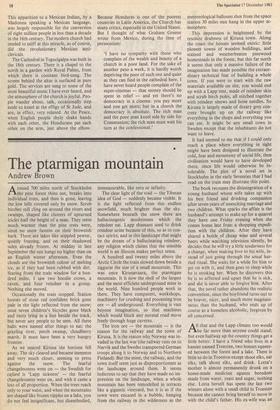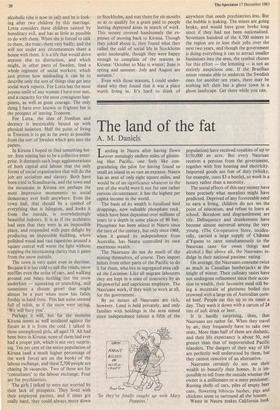The ptarmigan mountain
Andrew Brown
Around 700 miles north of Stockholm the pine forest thins out, breaks into individual trees, and then is gone, leaving the low hills covered only by snow. Scrub birches still cling on around the rivers and swamps, shaped like clusters of upturned icicles half the height of a man. They seem much warmer than the pine trees were, since no snow fastens on their brownish bark. There are lakes like stippled pewter, quietly freezing, and on their shadowed sides already frozen. At midday in late September the sun hangs no higher than on an English winter afternoon. Even the clouds are the brownish colour of melting ice, as if they had been rubbed with dirt. Staring from the train window for a hun- dred miles, I saw two hoodie crows, a raven, and four reindeer in a group. Nothing else moved.
Occasionally the train stopped. Station houses of stout red confident brick gone pale in the light reflected from the snow; once seven children's bicycles gone black and rusty lying in a line beside the track, but never any people to be seen. All these halts were named after things to eat: the grayling river, perch swamp, cloudberry marsh. It must have been a very hungry frontier.
As we neared Kiruna the horizon fell away. The sky cleared and became immense and very much closer, seeming to press against the snow. The fearful changelessness went on — the Swedish for cafard is 'Lapp sickness' — the fearful changelessness went on, and with it came a loss of all proportion. When the trees reach only to your waist, and when the mountains are shaped like frozen ripples on a lake, you do not feel insignificant, but disembodied,
immeasurable, like zero or infinity.
The clear light of the void — the Tibetan idea of God — suddenly became visible. It is the light reflected from this endless snowfield, much brighter than the sky. Somewhere beneath the snow there are hallucinogenic mushrooms which the reindeer eat. Lapp shamans used to drink reindeer urine because of this, so as to con- tact spirits; and in this landscape that might be the dream of a hallucinating reindeer, any religion which claims that the sensible world is an illusion makes perfect sense.
A hundred and twenty miles above the Arctic Circle the train slowed down beside a ziggurat the size of a small mountain. This was once Kirunavaara, the ptarmigan mountain. It is now the shell of the largest and the most efficient underground mine in the world. Nine hundred people work in there. They have computers, workshops, machinery for crushing and processing iron ore — all underground. Everything is vast beyone imagination, so that machines which would block any normal road move freely through huge caverns.
The iron ore — the mountain — is the reason for the railway and the town of Kiruna. It is the reason why Norway was in- vaded in the last war (the railway runs on to Narvik and the Swedes transported German troops along it to Norway and to Northern Finland). But the mine, the railway, and the town itself seem just as disproportionate as the landscape around them. It seems ludicrous to say that they have made no im- pression on the landscape, when a whole mountain has been remodelled in terraces like a gigantic vineyard, but it is as if the town were encased in a bubble, hanging from the railway in the wilderness as the metereological balloons shot from the space station 30 miles east hang in the upper at- mosphere.
This impression is heightened by the resolute drabness of Kiruna town. Along the coast the houses seemed exotic: little pioneer towns of wooden buildings, and stained and weatherbeaten pinewood homesteads in the forest, but this far north it seems that only a massive failure of the imagination has made possible the extraor- dinary technical feat of building a whole town. If you were to start with the raw materials available on site, you would end up with a Lapp tent, made of reindeer skin and scrub birch poles, all stitched together with reindeer sinews and bone needles. So Kiruna is largely made of dreary grey con- crete brought up on the railway like everything in the shops and everything you can eat. It might be any small town in Sweden except that the inhabitants do not want to leave.
It had seemed to me that if I could only reach a place where everything in sight might have been designed to illustrate the cold, fear and monotony of social life, then civilisation would have to have developed there, since life would otherwise be in- tolerable. The plot of a novel set in Stockholm in the early Seventies that I had read on the train may illustrate this point.
The book recounts the disintegration of a young husband whose wife takes up with his best friend and drinking companion after seven years of unexciting marriage and two children. What sparks the affair is the husband's attempt to make up for a quarrel they have one Friday evening when she comes home late from a shopping expedi- tion with the children. After they have shared a bottle of cheap wine and several beers while watching television silently, he decides that he will try a little tenderness for a change, when making love to his wife, in- stead of just going through the usual hur- ried ritual. She waits for a while for him to get on with it, and then goes to sleep while he is stroking her. When he discovers this he is so affected and upset that he is sick, and she is never able to forgive him. After that, the novel rather abandons the realistic convention, since the boyfriend turns out to be braver, nicer, and much more magnani- mous than the husband, who ends up of course as a homeless alcoholic, forgiven by all concerned.
AI that and the Lapp climate too would ..be far more than anyone could stand; but even halfway up the country things get a little better. I have a friend who lives in a hamlet named Troesten, two houses squeez- ed between the forest and a lake. There is little to do in Troesten except shoot elks, eat elks, talk about elks, and drink. Lotta's mother is almost permanently drunk on a home-made medicine against boredom made from water, yeast and sugar, nothing else. Lotta herself has spent the last two winters alone with a small child in Troesten because she cannot bring herself to move in with the child's father. His ex-wife was an
alcoholic (she is now in jail) and he is look- ing after two children by this marriage.
Lotta considers these children tainted by hereditary evil, and has as little as possible to do with them. When she is forced to talk to them, she treat; them very badly; and she will not under any circumstances share a house with them. It is a life that would drive anyone else to distraction, and which might, in other parts of Sweden, feed a whole regiment of social workers; which just proves how misleading it can be to describe only the sort of things that get into social work reports. For Lotta has the most joyous smile of any woman I have ever met, and a capacity for the most contagious hap- piness, as well as great courage. The only thing I have ever known to frighten her is the prospect of leaving Troesten.
For Lotta, the idea of freedom and decency is inextricably bound up with physical isolation. Half the point of living in Troesten is to get as far away as possible from the sort of Sweden which gets into the papers.
In Kiruna I hoped to find something bet- ter. Iron mining has to be a collective enter- prise. It demands such huge agglomerations of both capital and labour that the only forms of social organisation that will do the job are socialism and slavery. Both have been tried in Scandinavia, and the town and the mountain in Kiruna are perhaps the most impressive monuments to social democracy ever built anywhere. Even the town hall, that should be a symbol of everything that is Islington, and looks it from the outside, is overwhelmingly beautiful indoors. It is as if the architects had seen that they were in an impossible place, and responded with pure delight by producing an impossible building, where polished wood and vast tapestries around a square central well warm the light without trapping the intoxicating clarity that it gains from the snow outside.
The town is very quiet even in daytime. Because it is too cold to salt the roads, snow muffles even the noise of cars, and walking around one hears nothing but the snow underfoot — squeaking or crunching, and sometimes a distant growl that might almost be a purr when snow has fallen freshly in hard frost. This last noise seemed full of relish, as if the snow were saying, 'We will bury you'.
Perhaps it will, but for the moment Kiruna seems as well insulated against the future as it is from the cold. I talked to three unemployed girls, all aged 19. All had been born in Kiruna; none of them had ever had a proper job, which is not very surpris- ing. Ten per cent of the entire population of Kiruna (and a much higher percentage of the work force) are on the books of the labour exchange, and these 2,700 people are chasing 26 vacancies. Two of these are for 'consultants' to the labour exchange. Four are for psychiatrists.
The girls I talked to were not worried by their lack of prospects. They lived with their employed parents, and if times got really hard, they could always move down to Stockholm, and stay there for six months so as to qualify for a grant paid to people leaving depressed areas in search of work. This money covered handsomely the ex- penses of moving back to Kiruna. Though they joked about it, they found what they called the cold of social life in Stockholm quite intolerable, though they were happy enough to complain of the seasons in Kiruna: 'October to May is winter; June is spring and summer. July and August are autumn.'
Even with those seasons, I could under- stand why they found that it was a place worth living in. It's hard to think of anywhere that needs psychiatrists less. But the bubble is leaking. The mines are going broke, and would have gone broke long since if they had not been nationalised. Seventeen hundred of the 4,700 miners in the region are to lose their jobs over the next two years, and though the government is doing everything it can to attract smaller businesses into the area, the symbol chosen for this effort — the lemming — is not an entirely auspicious one. If the Brazilian mines remain able to undercut the Swedish ones for another ten years, there may be nothing left then but a ghost town in a ghost landscape. Get there while you can.







































































 Previous page
Previous page